Astronomical Chronology Framework of the Lingshui Formation (Oligocene) in the Northern South China Sea
Abstract
:1. Introduction
2. Regional Geological Setting
3. Materials and Methods
4. Results
4.1. Chronological Framework Determined by Planktonic Foraminifera
4.2. Optimal Paleoclimate Proxy
4.3. Time Series Analysis
4.4. Astronomical Chronology Analysis
4.5. Sedimentary Noise Modeling and Astronomical Forcing
5. Discussion
5.1. Geophysical Logging as a Proxy
5.2. Sea-Level Change Under Astronomical Forcing
6. Conclusions
Author Contributions
Funding
Institutional Review Board Statement
Informed Consent Statement
Data Availability Statement
Acknowledgments
Conflicts of Interest
References
- Xue, L.; Ding, X.; Pei, R.; Wan, X. Miocene paleoenvironmental evolution based on benthic foraminiferal assemblages in the Lufeng Sag, Northern South China Sea. Acta Oceanol. Sin. 2019, 38, 124–137. [Google Scholar] [CrossRef]
- Zhao, S.; Wang, Y.; Zhang, S.; Zhu, R.; Xu, E.; YI, Z.; Gong, G.; Wang, Y.; Liu, H. Miocene Paleoclimate Analysis of the Northern South China Sea: Response to Cooling Events Based on Astronomical Cycles. Mar. Geol. Front. 2022, 38, 53–62. (In Chinese) [Google Scholar] [CrossRef]
- Zhao, Q.; Wang, P. Progress in Quaternary Paleoceanography of the South China Sea: A Review. Quat. Sci. 1999, 19, 481–501. (In Chinese) [Google Scholar]
- Liu, X.; Xie, J.; Zhang, H.; He, W. Chronostratigraphy of Planktonic Foraminifera in the Yinggehai-Qiongdongnan Basin. Acta Micropalaeontol. Sin. 2009, 26, 181–192. (In Chinese) [Google Scholar]
- Cheng, S.; Li, S.; Suo, Y.; Liu, X.; Yu, S.; Dai, L.; Ma, Y.; Zhao, S.; Wang, X.; An, H.; et al. Cenozoic Tectonics and Dynamics of Basin Groups of the Northern South China Sea. Mar. Geol. Quat. Geol. 2012, 32, 79–93. (In Chinese) [Google Scholar] [CrossRef]
- Liu, S.; Chen, H.; Li, D.; Shun, W.; Li, C. Sedimentary characteristics and source rock development model of the Oligocene Lingshui Formation in Lingshui Sag, Qiongdongnan Basin. Mar. Orig. Pet. Geol. 2019, 24, 63–70. (In Chinese) [Google Scholar]
- Xie, H.; Zhou, D.; Shi, H.; Li, Y.; Kong, D. Comparative study on the Cenozoic tectonic and sedimentary evolution in the deep water areas of the Zhujiang River Estuary Basin and the Qiongdongnan Basin. Haiyang Xuebao 2021, 43, 48–61. (In Chinese) [Google Scholar]
- Zhu, J.; Yang, X.; Hu, X.; Luo, W.; Li, Y.; Mao, X.; Feng, S. Characteristic and petroleum geology of the Mesozoic sags of the northern Qiongdongnan Basin. Bull. Geol. Sci. Technol. 2023, 42, 83–93. (In Chinese) [Google Scholar] [CrossRef]
- Xu, C.; You, L. North slope transition zone of Songnan–Baodao sag in Qiongdongnan Basin and its control on medium and large gas fields, South China Sea. Pet. Explor. Dev. 2022, 49, 1061–1072. (In Chinese) [Google Scholar] [CrossRef]
- Zhang, S.; Xu, M.; Tang, W.; Xu, E.; Wang, Y.; Zhu, R. Cyclostratigraphy and paleoclimate analysis of Lingshui Formation in Beijiao Sag, Qiongdongnan Basin. Bull. Geol. Sci. Technol. 2024, 1–13. (In Chinese) [Google Scholar] [CrossRef]
- Wu, K.; Xie, X.; Pei, J.; Ren, J.; You, L.; Jiang, T.; Quan, Y. Deep architecture of hyperextended marginal basin and implications for hydrocarbon exploration: A case study of Qiongdongnan Basin. Oil Gas Geol. 2023, 44, 651–661. (In Chinese) [Google Scholar]
- Ding, W.; Hou, D.; Gan, J.; Wu, P.; Zhang, M.; George, S.C. Palaeovegetation variation in response to the late Oligocene-early Miocene East Asian summer monsoon in the Ying-Qiong Basin, South China Sea. Palaeogeogr. Palaeoclimatol. Palaeoecol. 2021, 567, 110205. [Google Scholar] [CrossRef]
- Cao, H.; Jin, S.; Hou, M.; Chen, S.; Liu, Y.; Chen, A. Astronomical cycles calibrated the sea-level sequence durations of Late Miocene to Pliocene in Qiongdongnan Basin, south China sea. Mar. Pet. Geol. 2022, 143, 105813. [Google Scholar] [CrossRef]
- Yang, H.; Tang, W.; Xu, E.; Zhang, S.; Wang, Y.; Xu, M. Cyclostratigraphy and paleoclimate analysis of the Lingshui Formation in Changchang Sag, Qiongdongnan Basin, China. Energy Geosci. 2024, 5, 100224. [Google Scholar] [CrossRef]
- Liu, X.; Sun, Z.; Liu, X.; Liu, D.; Zhai, S.; Long, H.; Jiang, L.; Bi, D. Chronostratigraphic Framework based on Micro-paleontological Data from Drilling LS33a in Deep Water Area of Northern South China Sea. Acta Sedimentol. Sin. 2018, 36, 890–902. (In Chinese) [Google Scholar] [CrossRef]
- Zhao, M. Evolution of Paleoenvironment in the Qiongdongnan Basin During the Cenozoic. Master’s Thesis, Ocean University of China, Qingdao, China, 2013. [Google Scholar]
- Hilgen, F.J.; Hinnov, L.A.; Abdul Aziz, H.; Abels, H.A.; Batenburg, S.; Bosmans, J.H.; de Boer, B.; Hüsing, S.K.; Kuiper, K.F.; Lourens, L.J. Stratigraphic Continuity and Fragmentary Sedimentation: The Success of Cyclostratigraphy as Part of Integrated Stratigraphy; The Geological Society of London: London, UK, 2015. [Google Scholar]
- Sageman, B.B.; Singer, B.S.; Meyers, S.R.; Siewert, S.E.; Walaszczyk, I.; Condon, D.J.; Jicha, B.R.; Obradovich, J.D.; Sawyer, D.A. Integrating 40Ar/39Ar, U-Pb, and astronomical clocks in the Cretaceous Niobrara Formation, Western Interior Basin, USA. Bulletin 2014, 126, 956–973. [Google Scholar] [CrossRef]
- Meyers, S.R. Cyclostratigraphy and the problem of astrochronologic testing. Earth-Sci. Rev. 2019, 190, 190–223. [Google Scholar] [CrossRef]
- Fang, Y.; Olsen, P.; Zheng, D.; Xue, N.; Wang, H.; Xu, C.; Li, S.; Wang, B.; Zhang, H. A new astronomical time scale for the early Jehol Biota in the Luanping Basin, northeastern China. Palaeogeogr. Palaeoclimatol. Palaeoecol. 2022, 607, 111273. [Google Scholar] [CrossRef]
- Olsen, P.E.; Kent, D.V. Milankovitch climate forcing in the tropics of Pangaea during the Late Triassic. Palaeogeogr. Palaeoclimatol. Palaeoecol. 1996, 122, 1–26. [Google Scholar] [CrossRef]
- Wu, H.; Zhang, S.; Hinnov, L.A.; Jiang, G.; Feng, Q.; Li, H.; Yang, T. Time-calibrated Milankovitch cycles for the late Permian. Nat. Commun. 2013, 4, 2452. [Google Scholar] [CrossRef] [PubMed]
- Hinnov, L.A. Cyclostratigraphy and astrochronology in 2018. In Stratigraphy & Timescales; Elsevier: Amsterdam, The Netherlands, 2018; Volume 3, pp. 1–80. [Google Scholar]
- Huang, C. Astronomical time scale for the Mesozoic. In Stratigraphy & Timescales; Elsevier: Amsterdam, The Netherlands, 2018; Volume 3, pp. 81–150. [Google Scholar]
- Wei, X.; Yan, D.; Wang, D.; Fu, H. Astronomically forced paleoclimate and sea-level changes recorded in the continental margin of the South China Sea over the past ~23 m.y. GSA Bull. 2024, 136, 3553–3568. [Google Scholar] [CrossRef]
- Huang, C.; Ogg, J.G.; Kemp, D.B. Cyclostratigraphy and astrochronology: Case studies from China. Palaeogeogr. Palaeoclimatol. Palaeoecol. 2020, 560, 110017. [Google Scholar] [CrossRef] [PubMed]
- Peng, C.; Zou, C.; Wu, H.; Zhang, S.; Kouamelan, K.S.; Wang, C. Evaluating geophysical logs as proxies for cyclostratigraphy in lacustrine deposits using power ratio accumulation. Palaeogeogr. Palaeoclimatol. Palaeoecol. 2023, 614, 111428. [Google Scholar] [CrossRef]
- Peng, C.; Zou, C.; Zhang, S.; Shu, J.; Wang, C. Geophysical logs as proxies for cyclostratigraphy: Sensitivity evaluation, proxy selection, and paleoclimatic interpretation. Earth-Sci. Rev. 2024, 252, 104735. [Google Scholar] [CrossRef]
- Xie, W.; Zhang, Y.; Sun, Z.; Jiang, J. Characteristics and Formation Mechanism of Faults in the Qiongdongnan Basin. Mar. Geol. Quat. Geol. 2007, 27, 71–78. (In Chinese) [Google Scholar] [CrossRef]
- Qiu, N.; Wang, Z.; Wang, Z.; Sun, Z.; Sun, Z.; Zhou, D. Tectonostratigraphic Structure and Crustal Extension of the Qiongdongnan Basin, Northern South China Sea. Chin. J. Geophys. 2014, 57, 3189–3207. (In Chinese) [Google Scholar]
- Li, C.; You, L.; Zhu, J.; Yang, J.; Wang, L. Effect of Fault Systems on Hydrocarbon Accumulation in the Central Depression Below the Deep Sea, Qiongdongnan Basin. Mar. Orig. Pet. Geol. 2016, 21, 73–78. (In Chinese) [Google Scholar]
- Shao, L.; Li, A.; Wu, G.; Li, Q.; Liu, C.; Qiao, P. Evolution of Sedimentary Environment and Provenance in the Qiongdongnan Basin, Northern South China Sea. Acta Pet. Sin. 2010, 31, 548–552. (In Chinese) [Google Scholar]
- Li, Y.; Deng, Y.; Zhang, G. Zoned Distribution of Source Rocks and Hydrocarbons Offshore China. China Offshore Oil Gas 2012, 24, 6–12. (In Chinese) [Google Scholar]
- Wang, Z.; Li, X.; Sun, Z.; Huang, B.; Zhu, J.; Yao, Z.; Guo, M. Hydrocarbon Accumulation Conditions and Exploration Potential in the Deep-Water Region, Qiongdongnan Basin. China Offshore Oil Gas 2011, 23, 7–13+31. (In Chinese) [Google Scholar]
- Wade, B.S.; Pearson, P.N.; Berggren, W.A.; Pälike, H. Review and revision of Cenozoic tropical planktonic foraminiferal biostratigraphy and calibration to the geomagnetic polarity and astronomical time scale. Earth-Sci. Rev. 2011, 104, 111–142. [Google Scholar] [CrossRef]
- Cohen, K.M.; Finney, S.C.; Gibbard, P.L.; Fan, J.X. The ICS International Chronostratigraphic Chart. Int. Union Geol. Sci. 2013, 36, 199–204. [Google Scholar] [CrossRef] [PubMed]
- Thomson, D.J. Spectrum estimation and harmonic analysis. Proc. IEEE 1982, 70, 1055–1096. [Google Scholar] [CrossRef]
- Mann, M.E.; Lees, J.M. Robust estimation of background noise and signal detection in climatic time series. Clim. Chang. 1996, 33, 409–445. [Google Scholar] [CrossRef]
- Kodama, K.P.; Hinnov, L.A. Rock Magnetic Cyclostratigraphy; John Wiley & Sons: Hoboken, NJ, USA, 2014; Volume 5. [Google Scholar]
- Li, M.; Kump, L.R.; Hinnov, L.A.; Mann, M.E. Tracking variable sedimentation rates and astronomical forcing in Phanerozoic paleoclimate proxy series with evolutionary correlation coefficients and hypothesis testing. Earth Planet. Sci. Lett. 2018, 501, 165–179. [Google Scholar] [CrossRef]
- Laskar, J.; Fienga, A.; Gastineau, M.; Manche, H. La2010: A new orbital solution for the long-term motion of the Earth. Astron. Astrophys. 2011, 532, A89. [Google Scholar] [CrossRef]
- Li, M.; Hinnov, L.A.; Huang, C.; Ogg, J.G. Sedimentary noise and sea levels linked to land–ocean water exchange and obliquity forcing. Nat. Commun. 2018, 9, 1004. [Google Scholar] [CrossRef] [PubMed]
- Berggren, W.A.; Kent, D.V.; Swisher, C.C., III; Aubry, M.-P. A Revised Cenozoic Geochronology and Chronostratigraphy. Geochronol. Time Scales Glob. Stratigr. Correl. 1995, 54, 129–212. [Google Scholar] [CrossRef]
- Tang, Y.; Zheng, M.; Wang, X.; Wang, T.; Cheng, H.; Hei, C. The floating astronomical time scale for the terrestrial Early Permian Fengcheng Formation from the Junggar Basin and its stratigraphic and palaeoclimate implications. Geol. J. 2022, 57, 4842–4856. [Google Scholar] [CrossRef]
- Li, Y.; Yang, R.; Fan, A.; Chen, J.; Bilal, A.; Wang, Z. Establishment of a high-resolution astronomical time scale and high-frequency sequence framework of Paleogene lacustrine fine-grained sediments using logging data: A case study from the Bohai Bay Basin, East China. Mar. Pet. Geol. 2025, 172, 107220. [Google Scholar] [CrossRef]
- Liu, S.; Jin, S.; Liu, Y.; Chen, A. Astronomical forced sequence infill of Early Cambrian Qiongzhusi organic-rich shale of Sichuan Basin, South China. Sediment. Geology 2022, 440, 106261. [Google Scholar] [CrossRef]
- Falahatkhah, O.; Serajamani, M.; Kadkhodaie, A.; Aïfa, T.; Ebrahimi, S.; Ciabeghodsi, A.A.; Zamanzadeh, S.M.; Sfidari, E.; Vahidinia, M.; Ghaderi, A. Orbital obliquity evolution during the late Paleozoic ice age across the northeastern gondwana: Implications for regional sea-level change trigger and reservoir quality assessment. Mar. Pet. Geol. 2023, 153, 106312. [Google Scholar] [CrossRef]
- Falahatkhah, O.; Kordi, M.; Fatemi, V.; Koochi, H.H. Recognition of Milankovitch cycles during the Oligocene–Early Miocene in the Zagros Basin, SW Iran: Implications for paleoclimate and sequence stratigraphy. Sediment. Geol. 2021, 421, 105957. [Google Scholar] [CrossRef]
- Liu, Y.; Huang, C.; Ogg, J.G.; Algeo, T.J.; Kemp, D.B.; Shen, W. Oscillations of global sea-level elevation during the Paleogene correspond to 1.2-Myr amplitude modulation of orbital obliquity cycles. Earth Planet. Sci. Lett. 2019, 522, 65–78. [Google Scholar] [CrossRef]
- Zou, Z.; Huang, C.; Li, M.; Zhang, Y. Climate change response to astronomical forcing during the Oligocene-Miocene transition in the equatorial Atlantic (ODP Site 926). Sci. China Earth Sci. 2016, 59, 1665–1673. [Google Scholar] [CrossRef]
- Shi, J.; Jin, Z.; Liu, Q.; Zhang, R.; Huang, Z. Cyclostratigraphy and astronomical tuning of the middle eocene terrestrial successions in the Bohai Bay Basin, Eastern China. Glob. Planet. Chang. 2019, 174, 115–126. [Google Scholar] [CrossRef]
- Tian, J.; Xie, X.; Ma, W.; Jin, H.; Wang, P. X-ray fluorescence core scanning records of chemical weathering and monsoon evolution over the past 5 Myr in the southern South China Sea. Paleoceanography 2011, 26, 1r17. [Google Scholar] [CrossRef]
- Weedon, G.P.; Page, K.N.; Jenkyns, H.C. Cyclostratigraphy, stratigraphic gaps and the duration of the Hettangian Stage (Jurassic): Insights from the Blue Lias Formation of southern Britain. Geol. Mag. 2019, 156, 1469–1509. [Google Scholar] [CrossRef]
- Aziz, H.A.; Hilgen, F.J.; van Luijk, G.M.; Sluijs, A.; Kraus, M.J.; Pares, J.M.; Gingerich, P.D. Astronomical climate control on paleosol stacking patterns in the upper Paleocene–lower Eocene Willwood Formation, Bighorn Basin, Wyoming. Geology 2008, 36, 531–534. [Google Scholar] [CrossRef]
- Li, M.; Huang, C.; Ogg, J.; Zhang, Y.; Hinnov, L.; Wu, H.; Chen, Z.-Q.; Zou, Z. Paleoclimate proxies for cyclostratigraphy: Comparative analysis using a Lower Triassic marine section in South China. Earth-Sci. Rev. 2019, 189, 125–146. [Google Scholar] [CrossRef]
- Zeeden, C.; Ulfers, A.; Pierdominici, S.; Abadi, M.S.; Vinnepand, M.; Grelle, T.; Hesse, K.; Leu, K.; Wonik, T. Downhole logging data for time series analysis and cyclostratigraphy. Earth-Sci. Rev. 2023, 241, 104436. [Google Scholar] [CrossRef]
- Peng, C.; Zou, C.; Zhang, S.; Wu, H.; Lü, Q.; Hou, H.; Wang, C. Astronomically forced variations in multiresolution resistivity logs of lower Upper Cretaceous (Cenomanian-Coniacian) terrestrial formations from the Songliao Basin, northeastern China. Palaeogeogr. Palaeoclimatol. Palaeoecol. 2020, 555, 109858. [Google Scholar] [CrossRef]
- Demenocal, P.; Bristow, J.; Stein, R. Paleoclimatic applications of downhole logs Plio-Pleistocene results from Hole 798B, Sea of Japan. Proc. ODP Sci. Results+ 128 1992, 127, 393–408. [Google Scholar]
- Aswasereelert, W.; Meyers, S.; Carroll, A.; Peters, S.; Smith, M.; Feigl, K. Basin-scale cyclostratigraphy of the Green River formation, Wyoming. Bulletin 2013, 125, 216–228. [Google Scholar] [CrossRef]
- Wang, C.; Hazen, R.M.; Cheng, Q.; Stephenson, M.H.; Zhou, C.; Fox, P.; Shen, S.-Z.; Oberhänsli, R.; Hou, Z.; Ma, X. The Deep-Time Digital Earth program: Data-driven discovery in geosciences. Natl. Sci. Rev. 2021, 8, nwab027. [Google Scholar] [CrossRef]
- Rider, M.H. The Geological Interpretation of Well Logs; Cambridge University Press: Cambridge, UK, 2018; pp. 67–86. [Google Scholar]
- Bahk, J.-J.; Um, I.-K.; Yi, B.-Y.; Yoo, D.-G. Paleoceanographic implications and cyclostratigraphy of variations in well-log data from the western slope of the Ulleung Basin, East Sea. Quat. Int. 2016, 392, 58–68. [Google Scholar] [CrossRef]
- Ochoa, D.; Sierro, F.J.; Hilgen, F.J.; Cortina, A.; Lofi, J.; Kouwenhoven, T.; Flores, J.-A. Origin and implications of orbital-induced sedimentary cyclicity in Pliocene well-logs of the Western Mediterranean. Mar. Geol. 2018, 403, 150–164. [Google Scholar] [CrossRef]
- Sierro, F.J.; Ledesma, S.; Flores, J.-A.; Torrescusa, S.; del Olmo, W.M. Sonic and gamma-ray astrochronology: Cycle to cycle calibration of Atlantic climatic records to Mediterranean sapropels and astronomical oscillations. Geology 2000, 28, 695–698. [Google Scholar] [CrossRef]
- Marra, F.; Florindo, F. The subsurface geology of Rome: Sedimentary processes, sea-level changes and astronomical forcing. Earth-Sci. Rev. 2014, 136, 1–20. [Google Scholar] [CrossRef]
- Wendler, J.E.; Meyers, S.R.; Wendler, I.; Kuss, J. A million-year-scale astronomical control on Late Cretaceous sea-level. Newsl. Stratigr. 2014, 47, 1–19. [Google Scholar] [CrossRef]
- Shi, J.; Fan, T.; Jin, Z.; Liu, Q.; Zhang, T.; Jiang, M.; Wang, B. Astronomical Forcing of Sea-Level Changes and the History of the Solar System 1640 Million Years Ago. J. Geophys. Res. Solid Earth 2023, 128, e2023JB027050. [Google Scholar] [CrossRef]
- Crucifix, M.; Loutre, M.-F.; Berger, A. The climate response to the astronomical forcing. Space Sci. Rev. 2006, 125, 213–226. [Google Scholar] [CrossRef]
- Haigh, J.D. The Earth’s Climate and Its Response to Solar Variability. In The Sun, Solar Analogs and the Climate: Saas-Fee Advanced Course 34 2004 Swiss Society for Astrophysics and Astronomy; Haigh, J.D., Giampapa, M.S., Lockwood, M., Rüedi, I., Schmutz, W., Güdel, M., Eds.; Springer: Berlin/Heidelberg, Germany, 2005; pp. 1–107. [Google Scholar]
- Milankovitch, M. Kanon der Erdbestrahlung und seine Anwendung auf das Eiszeitenproblem. R. Serbian Acad. Spec. Publ. 1941, 133, 1–633. [Google Scholar]
- Rohling, E.J.; Yu, J.; Heslop, D.; Foster, G.L.; Opdyke, B.; Roberts, A.P. Sea level and deep-sea temperature reconstructions suggest quasi-stable states and critical transitions over the past 40 million years. Sci. Adv. 2021, 7, eabf5326. [Google Scholar] [CrossRef] [PubMed]
- Woodworth, P.L.; Melet, A.; Marcos, M.; Ray, R.D.; Wöppelmann, G.; Sasaki, Y.N.; Cirano, M.; Hibbert, A.; Huthnance, J.M.; Monserrat, S.; et al. Forcing Factors Affecting Sea Level Changes at the Coast. Surv. Geophys. 2019, 40, 1351–1397. [Google Scholar] [CrossRef]


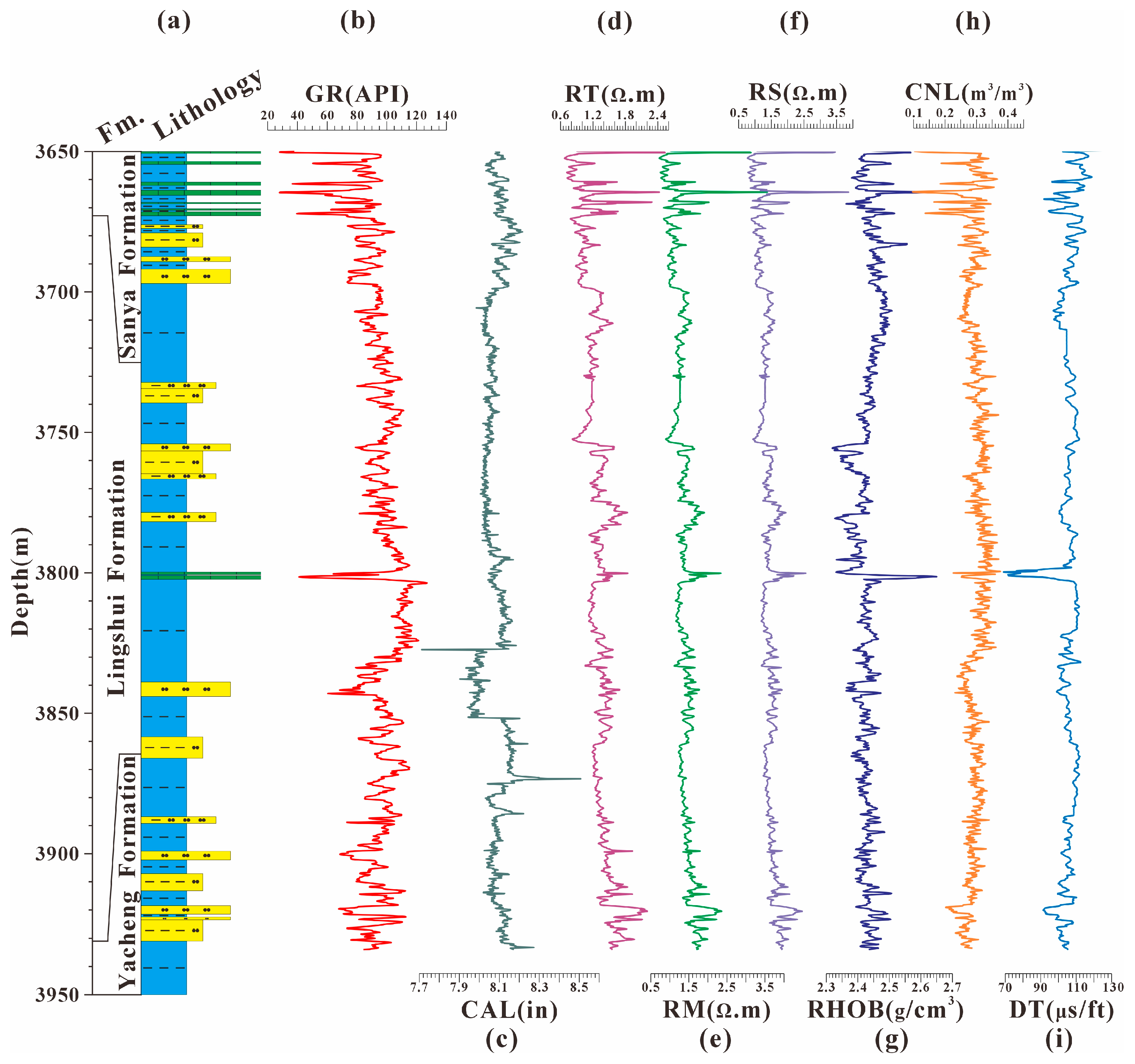
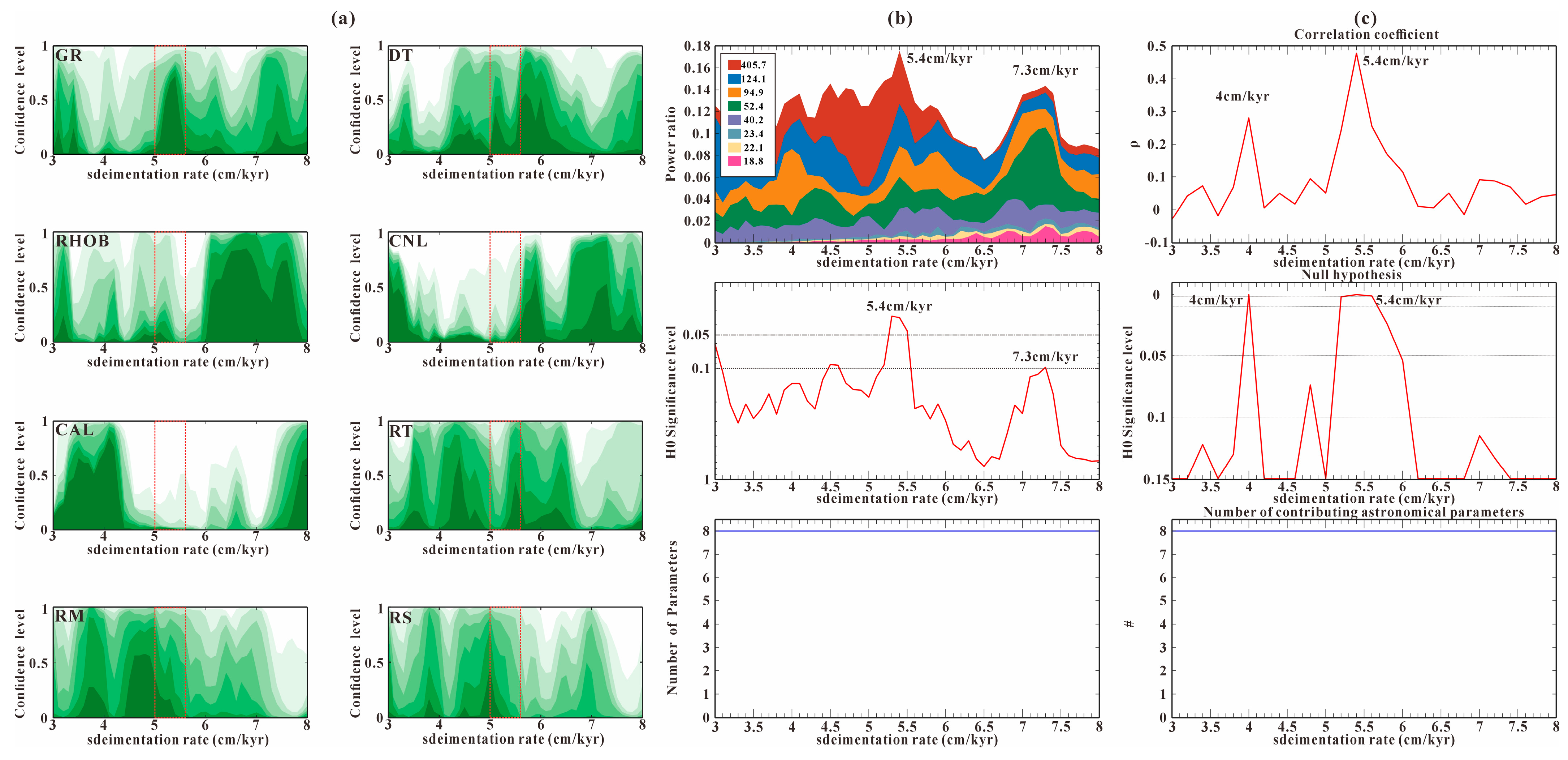
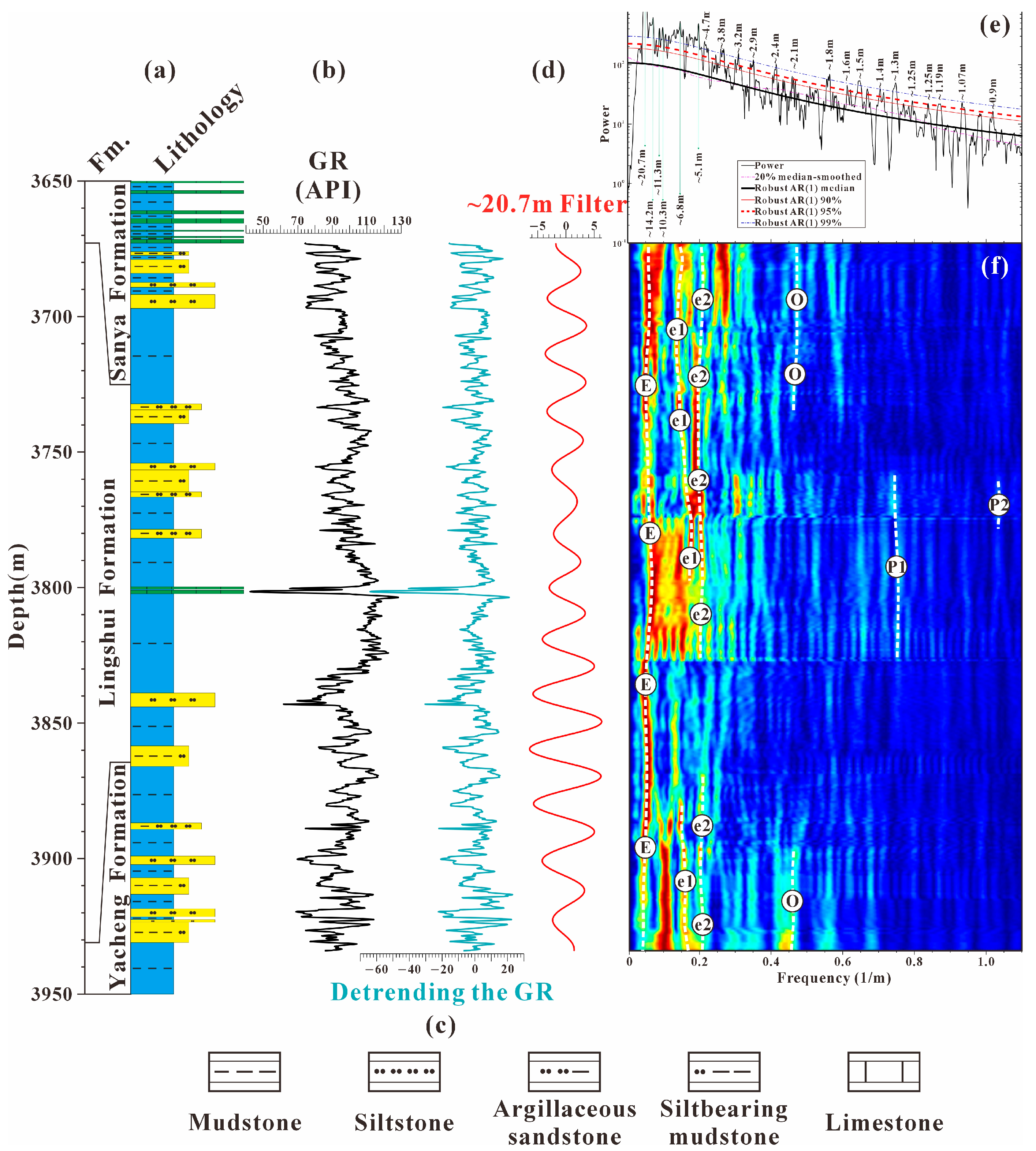
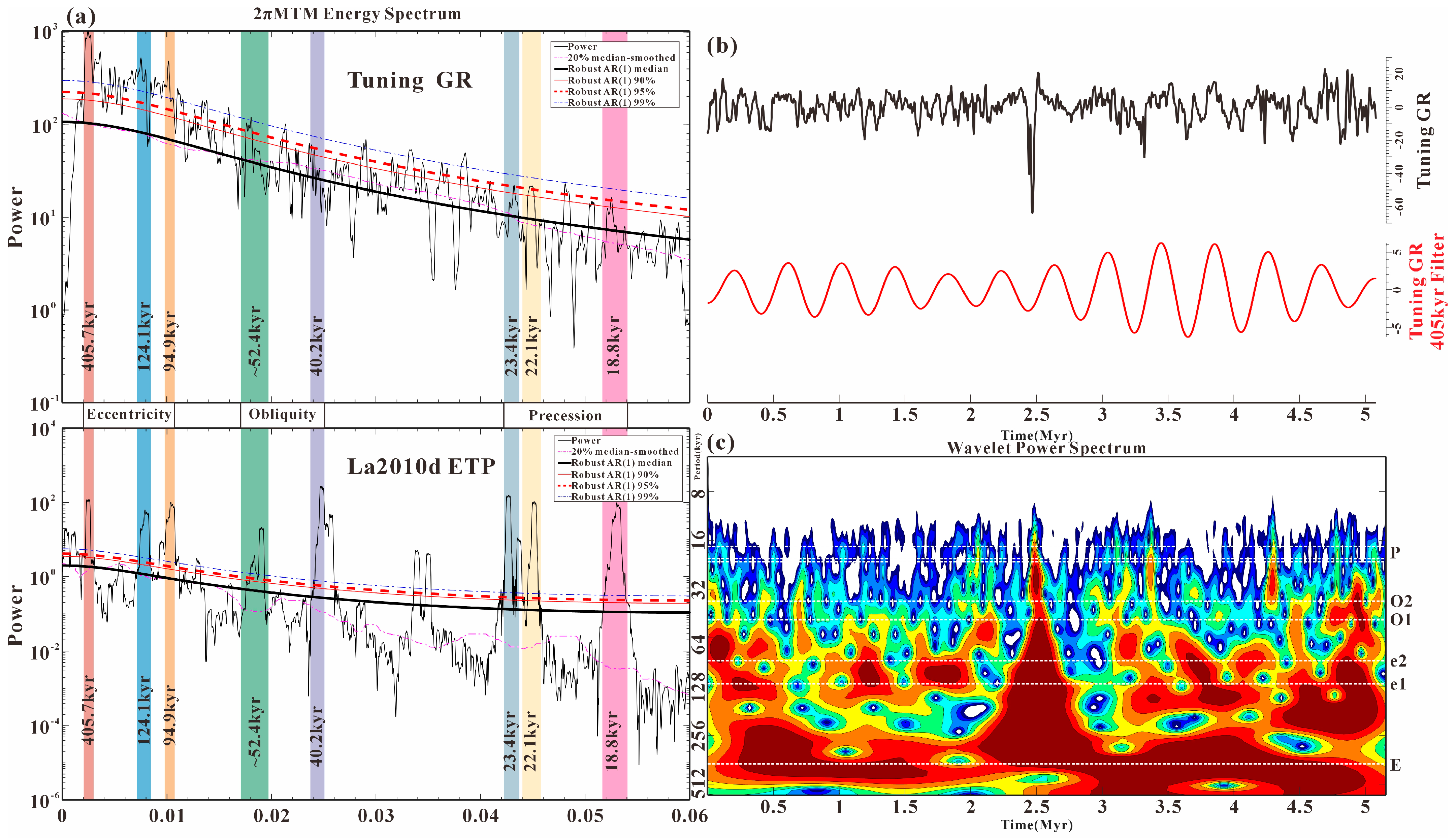

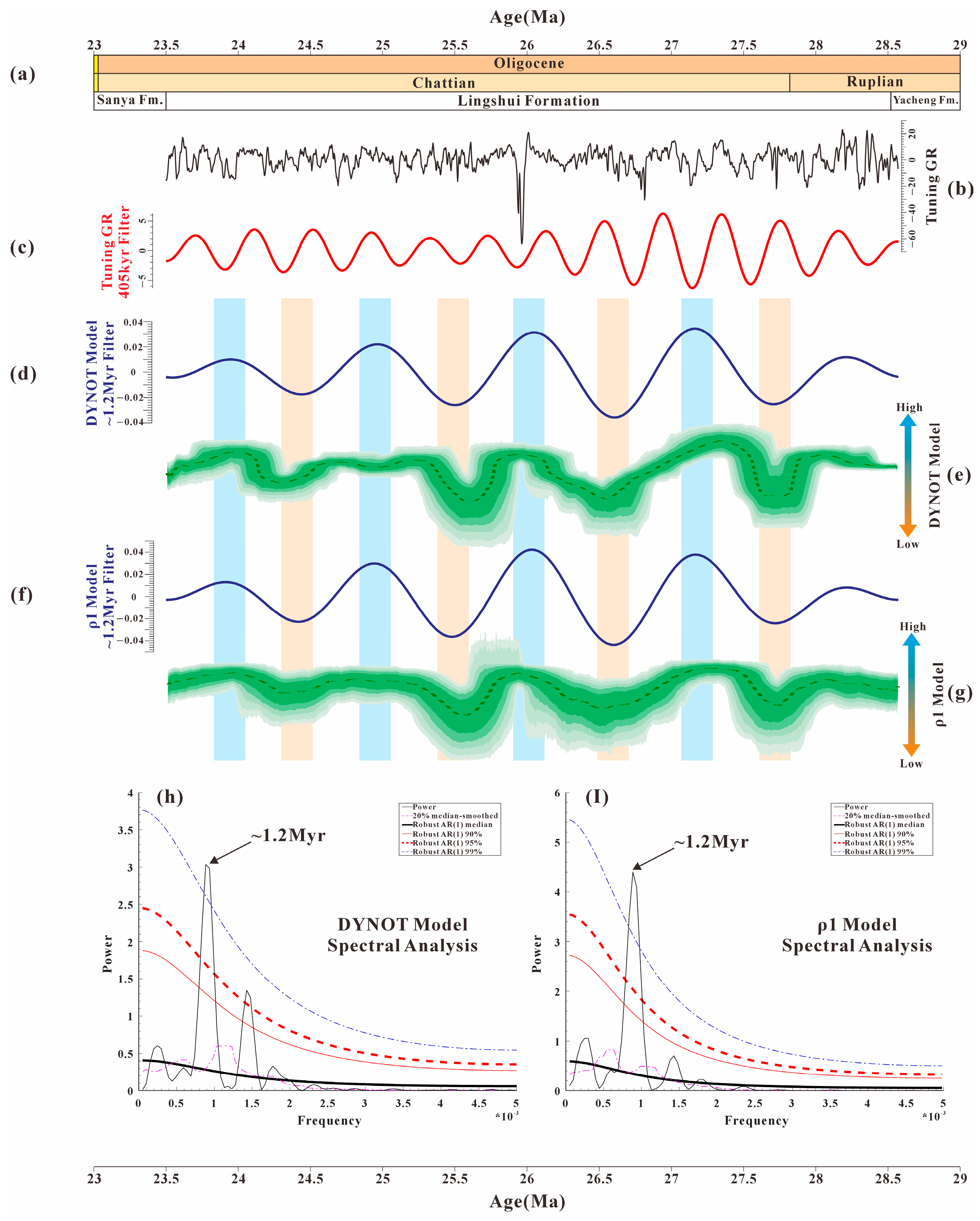
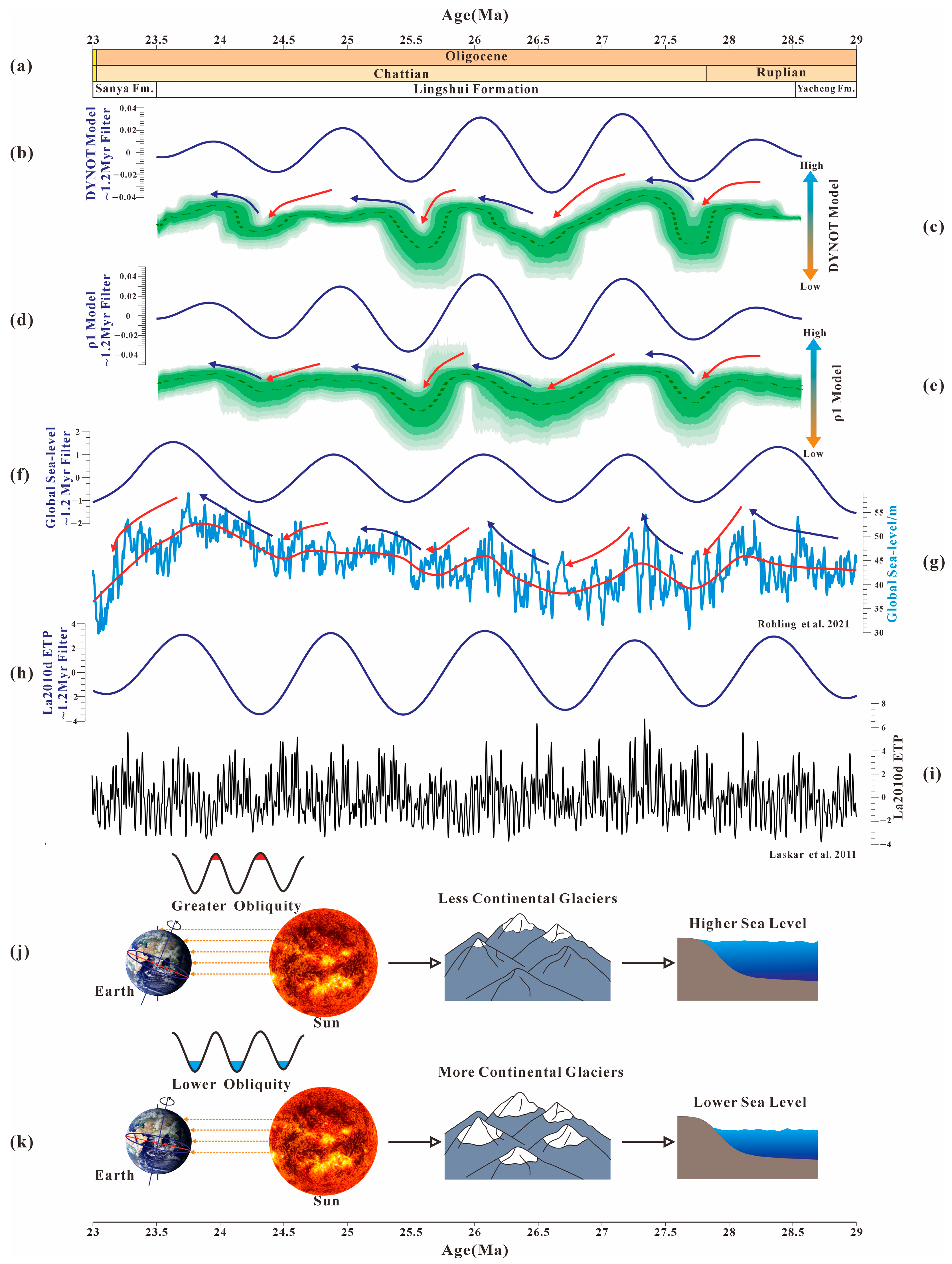
Disclaimer/Publisher’s Note: The statements, opinions and data contained in all publications are solely those of the individual author(s) and contributor(s) and not of MDPI and/or the editor(s). MDPI and/or the editor(s) disclaim responsibility for any injury to people or property resulting from any ideas, methods, instructions or products referred to in the content. |
© 2025 by the authors. Licensee MDPI, Basel, Switzerland. This article is an open access article distributed under the terms and conditions of the Creative Commons Attribution (CC BY) license (https://creativecommons.org/licenses/by/4.0/).
Share and Cite
Liang, J.; Wang, Y.; Zhang, S.; Liang, Y.; Gong, G.; Han, R. Astronomical Chronology Framework of the Lingshui Formation (Oligocene) in the Northern South China Sea. J. Mar. Sci. Eng. 2025, 13, 86. https://doi.org/10.3390/jmse13010086
Liang J, Wang Y, Zhang S, Liang Y, Gong G, Han R. Astronomical Chronology Framework of the Lingshui Formation (Oligocene) in the Northern South China Sea. Journal of Marine Science and Engineering. 2025; 13(1):86. https://doi.org/10.3390/jmse13010086
Chicago/Turabian StyleLiang, Jianhao, Yaning Wang, Shangfeng Zhang, Yubing Liang, Gaoyang Gong, and Rui Han. 2025. "Astronomical Chronology Framework of the Lingshui Formation (Oligocene) in the Northern South China Sea" Journal of Marine Science and Engineering 13, no. 1: 86. https://doi.org/10.3390/jmse13010086
APA StyleLiang, J., Wang, Y., Zhang, S., Liang, Y., Gong, G., & Han, R. (2025). Astronomical Chronology Framework of the Lingshui Formation (Oligocene) in the Northern South China Sea. Journal of Marine Science and Engineering, 13(1), 86. https://doi.org/10.3390/jmse13010086





